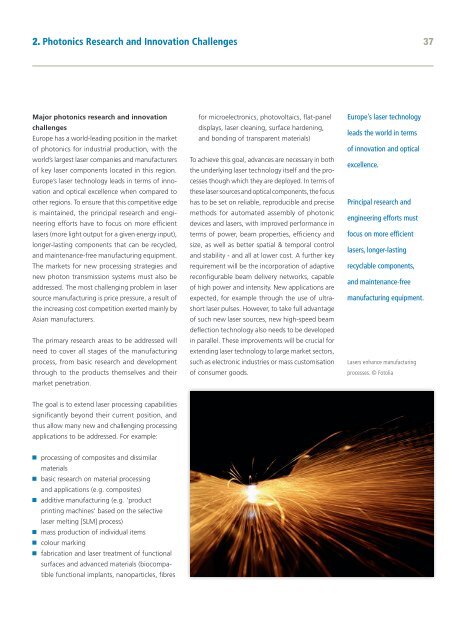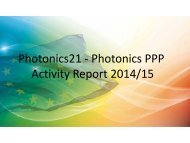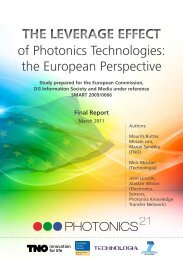Towards 2020 – Photonics driving economic growth in Europe
Create successful ePaper yourself
Turn your PDF publications into a flip-book with our unique Google optimized e-Paper software.
2. <strong>Photonics</strong> Research and Innovation Challenges<br />
37<br />
Major photonics research and <strong>in</strong>novation<br />
challenges<br />
<strong>Europe</strong> has a world-lead<strong>in</strong>g position <strong>in</strong> the market<br />
of photonics for <strong>in</strong>dustrial production, with the<br />
world’s largest laser companies and manufacturers<br />
of key laser components located <strong>in</strong> this region.<br />
<strong>Europe</strong>’s laser technology leads <strong>in</strong> terms of <strong>in</strong>novation<br />
and optical excellence when compared to<br />
other regions. To ensure that this competitive edge<br />
is ma<strong>in</strong>ta<strong>in</strong>ed, the pr<strong>in</strong>cipal research and eng<strong>in</strong>eer<strong>in</strong>g<br />
efforts have to focus on more efficient<br />
lasers (more light output for a given energy <strong>in</strong>put),<br />
longer-last<strong>in</strong>g components that can be recycled,<br />
and ma<strong>in</strong>tenance-free manufactur<strong>in</strong>g equipment.<br />
The markets for new process<strong>in</strong>g strategies and<br />
new photon transmission systems must also be<br />
addressed. The most challeng<strong>in</strong>g problem <strong>in</strong> laser<br />
source manufactur<strong>in</strong>g is price pressure, a result of<br />
the <strong>in</strong>creas<strong>in</strong>g cost competition exerted ma<strong>in</strong>ly by<br />
Asian manufacturers.<br />
The primary research areas to be addressed will<br />
need to cover all stages of the manufactur<strong>in</strong>g<br />
process, from basic research and development<br />
through to the products themselves and their<br />
market penetration.<br />
for microelectronics, photovoltaics, flat-panel<br />
displays, laser clean<strong>in</strong>g, surface harden<strong>in</strong>g,<br />
and bond<strong>in</strong>g of transparent materials)<br />
To achieve this goal, advances are necessary <strong>in</strong> both<br />
the underly<strong>in</strong>g laser technology itself and the processes<br />
though which they are deployed. In terms of<br />
these laser sources and optical components, the focus<br />
has to be set on reliable, reproducible and precise<br />
methods for automated assembly of photonic<br />
devices and lasers, with improved performance <strong>in</strong><br />
terms of power, beam properties, efficiency and<br />
size, as well as better spatial & temporal control<br />
and stability - and all at lower cost. A further key<br />
requirement will be the <strong>in</strong>corporation of adaptive<br />
reconfigurable beam delivery networks, capable<br />
of high power and <strong>in</strong>tensity. New applications are<br />
expected, for example through the use of ultrashort<br />
laser pulses. However, to take full advantage<br />
of such new laser sources, new high-speed beam<br />
deflection technology also needs to be developed<br />
<strong>in</strong> parallel. These improvements will be crucial for<br />
extend<strong>in</strong>g laser technology to large market sectors,<br />
such as electronic <strong>in</strong>dustries or mass customisation<br />
of consumer goods.<br />
<strong>Europe</strong>’s laser technology<br />
leads the world <strong>in</strong> terms<br />
of <strong>in</strong>novation and optical<br />
excellence.<br />
Pr<strong>in</strong>cipal research and<br />
eng<strong>in</strong>eer<strong>in</strong>g efforts must<br />
focus on more efficient<br />
lasers, longer-last<strong>in</strong>g<br />
recyclable components,<br />
and ma<strong>in</strong>tenance-free<br />
manufactur<strong>in</strong>g equipment.<br />
Lasers enhance manufactur<strong>in</strong>g<br />
processes. © Fotolia<br />
The goal is to extend laser process<strong>in</strong>g capabilities<br />
significantly beyond their current position, and<br />
thus allow many new and challeng<strong>in</strong>g process<strong>in</strong>g<br />
applications to be addressed. For example:<br />
n process<strong>in</strong>g of composites and dissimilar<br />
materials<br />
n basic research on material process<strong>in</strong>g<br />
and applications (e.g. composites)<br />
n additive manufactur<strong>in</strong>g (e.g. ‘product<br />
pr<strong>in</strong>t<strong>in</strong>g mach<strong>in</strong>es’ based on the selective<br />
laser melt<strong>in</strong>g [SLM] process)<br />
n mass production of <strong>in</strong>dividual items<br />
n colour mark<strong>in</strong>g<br />
n fabrication and laser treatment of functional<br />
surfaces and advanced materials (biocompatible<br />
functional implants, nanoparticles, fibres






